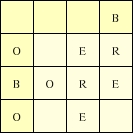Anatomy of an Extreme Crossword PuzzleAn extreme crossword has three eye-catching grids of smaller squares which are either blank or else already filled in with individual letters or individual digits.None of the squares are blackened, so entire rows and columns of the squares harbor identically-sized niches for words across and down. All of the words are mutually contingent, since all of the niches across intersect all of the niches down.
Publishing ConventionsThe sibling grids are published together. Forthright looks at the abstract solution are de rigueur, but furtive glances at the concrete solution are discouraged by exposing the letters only upon demand: extreme crosswords are applets that provide a lexicon and enable you to fill in the puzzle grid, backtrack, flip the concrete solution, and more, simply by pointing and clicking.
CluesAn extreme crossword also has a single table of unary clues. The clues lack niche handles until you (implicitly) assign them yourself, and have extra word definitions that are bogus noise not bonus signal.
MethodologyFill out the puzzle grid. Solve the extreme crossword niche by niche. Think of words that simultaneously satisfy (a) the abstract solution, (b) the word definitions, (c) the orthogonal word templates formed by the words that you have already lodged in the puzzle grid, and (d) any additional letters that may have popped up in the puzzle grid here and there in odd squares.But do not set your words directly into the puzzle grid. First fill out the staging area, which is located to the right of the definitions in the table of clues, before filling out the puzzle grid itself:
Digital PatternsOnce you have prepared the staging area to your initial satisfaction and are ready to begin setting words into the puzzle grid, consult the abstract solution where each niche has a digital pattern. The first niches to attack are those with repeated letters repeated in them. Neglect the other niches until word templates develop in the puzzle grid.
Absent the word definitions, of course, any word such as agog, anon, bolo, bozo, cede, data, dele, dojo, fete, gala, gene, gobo, guru, here, hobo, imam, java, kana, kava, kiwi, kudu, lama, lava, lobo, loco, logo, luau, mere, mete, midi, mini, mono, nada, pogo, polo, raga, raja, tipi, or ziti might potentially do for digital pattern 0242. These and many more words besides are qualified for niche 3d simply on the basis of its digital pattern. Fortunately, the word definitions effectively vet the word candidates for a particular digital pattern so that you are not likely to find more than a couple of words in the staging area with the same second-letter and fourth-letter, in this example, which is a more manageable number of alternatives for trial and error. But what if the problem is the opposite of there being too many words in the staging-area that are qualified for a particular digital pattern? Not only trial and error but also several procedural spirals are typically required to fill out the puzzle grid correctly:
Side EffectsBesides the main effect of filling in a puzzle row or puzzle column, look around for a couple of startling side effects each time you assign a definition/word to a puzzle niche:
Notice that in the process of (explicitly) assigning a definition/word to a puzzle niche you are also (implicitly) assigning a niche handle to a clue and asserting that the definition is bona fide.
Word TemplatesIn the process of filling out the puzzle grid, the array of orthogonal word templates developing there may either seem promising and help fill in the remaining niches, or else seem hopeless and signal you to backtrack and try again.
|




